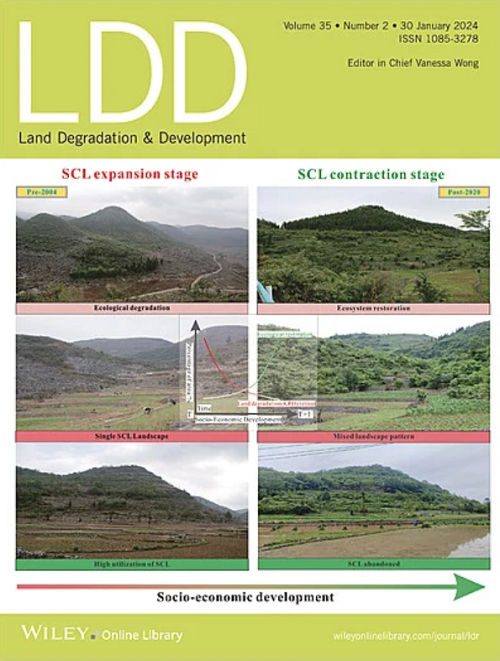黄土高原人工林景观破碎化的多尺度敏感性分析
IF 3.6
2区 农林科学
Q2 ENVIRONMENTAL SCIENCES
引用次数: 0
摘要
有效量化人工林破碎化对黄土高原植被恢复与管理具有重要意义。森林面积密度(FAD)是衡量森林破碎度的有效指标,多尺度敏感性分析是确定合适的窗尺度阈值的关键。本研究利用黄土高原不同地貌类型(丘陵沟壑区和高原沟壑区)的人工林数据。采用不同窗口大小评价FAD阈值曲线及其导数,确定稳定的破碎化阈值,采用结构方程模型分析森林破碎化驱动因素。结果表明:(1)FAD变异率随窗口大小的增大而减小,达到阈值后趋于平稳。(2)不同森林类型和县域的阈值不同。(3)两个主成分解释了81.27%的窗稳定阈值变化,相似破碎类型之间具有较强的相关性。(4) 2000 - 2022年,破碎化程度有所减缓,丘陵沟壑区破碎化程度高于高原沟壑区。(5)林分结构缓解了破碎化,地形和气候变化对林分结构的影响呈现异质性。“核心”保持稳定,“小岛”驱动碎片化。本研究强调了尺度分析和适应性管理策略在缓解森林破碎化中的重要性。本研究为优化生态修复和有针对性的保护策略,促进黄土高原森林可持续经营提供了依据。本文章由计算机程序翻译,如有差异,请以英文原文为准。
Multiscale Sensitivity Analysis of Landscape Fragmentation in Plantation Forests on the Loess Plateau
Effectively quantifying plantation forest fragmentation is crucial for vegetation restoration and management on the Loess Plateau. Forest area density (FAD) effectively measures fragmentation, with multiscale sensitivity analysis essential for determining the appropriate window scale threshold. This study uses plantation forest data from different geomorphological types (hilly gully and plateau gully region) of the Loess Plateau. Various window sizes are applied to evaluate the FAD threshold curve and its derivative for determining a stable fragmentation threshold, while a structural equation model is employed to analyze the drivers of forest fragmentation. The results are as follows: (1) FAD variability decreases with increasing window size, leveling off after reaching the threshold. (2) Thresholds vary by forest type and county. (3) Two principal components explain 81.27% of the window stabilization threshold variation, with strong correlations between similar fragmentation types. (4) Fragmentation slowed between 2000 and 2022, with hilly gully region more fragmented than plateau gully region. (5) Stand structure mitigates fragmentation, with topographic and climate change influences showing heterogeneity. “Core” maintain stability, while “Islet” drive fragmentation. This study emphasizes the importance of scale‐specific analysis and adaptive management strategies in mitigating forest fragmentation. This study supports optimizing ecological restoration and targeted conservation strategies, promoting sustainable forest management on the Loess Plateau.
求助全文
通过发布文献求助,成功后即可免费获取论文全文。
去求助
来源期刊

Land Degradation & Development
农林科学-环境科学
CiteScore
7.70
自引率
8.50%
发文量
379
审稿时长
5.5 months
期刊介绍:
Land Degradation & Development is an international journal which seeks to promote rational study of the recognition, monitoring, control and rehabilitation of degradation in terrestrial environments. The journal focuses on:
- what land degradation is;
- what causes land degradation;
- the impacts of land degradation
- the scale of land degradation;
- the history, current status or future trends of land degradation;
- avoidance, mitigation and control of land degradation;
- remedial actions to rehabilitate or restore degraded land;
- sustainable land management.
 求助内容:
求助内容: 应助结果提醒方式:
应助结果提醒方式:


